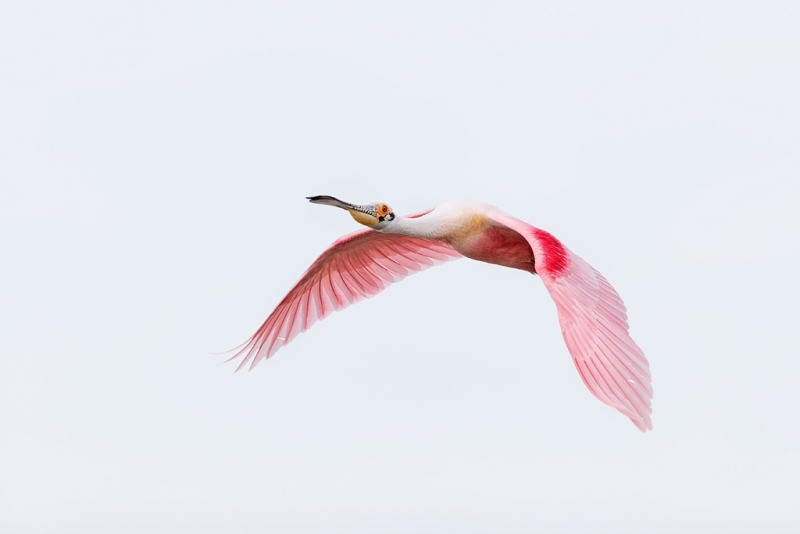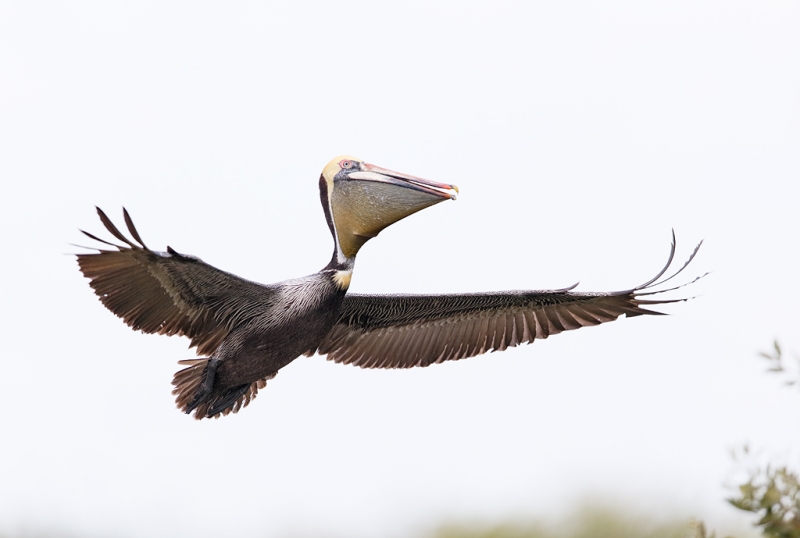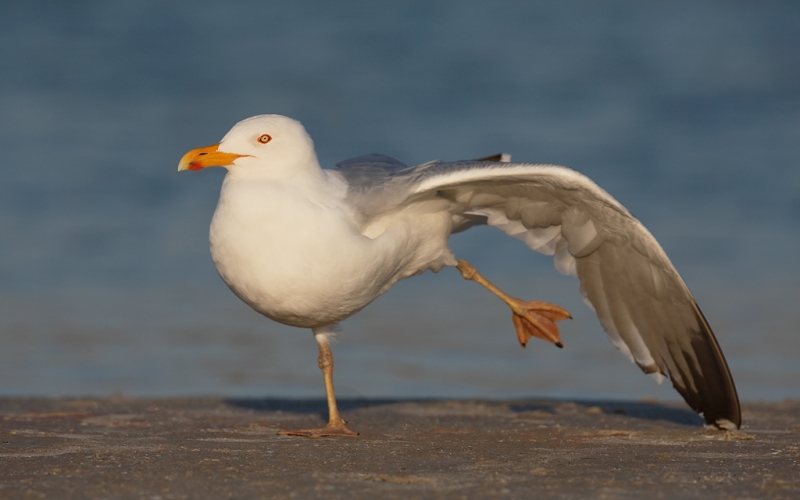|
This Roseate Spoonbill flight image was created on the Hooptie Deux with the tripod-mounted Canon EF 600mm f/4L IS II USM lens and the Canon EOS-1D X Digital SLR camera. ISO 800. Evaluative metering +2 1/3 stops off the white sky: 1/2000 sec. at f/4 in Manual mode. Exposure previously confirmed via histogram check. Central sensor/AI Servo Surround/Rear Focus AF active at the moment of exposure. Click here if you missed the Rear Focus Tutorial. Click on the image to see a larger version. |
How are Your Eagle Eyes?
Please take a close look at each of the three images here by clicking on them to see the larger version. Let us know if you see any evidence of Photoshop work, extensive or otherwise. Right now, I ain’t saying.
|
This Brown Pelican image was also created on the Hooptie Deux with the tripod-mounted Canon EF 600mm f/4L IS II USM lens and the Canon EOS-1D X Digital SLR camera. ISO 800. Evaluative metering +2 2/3 stops off the white sky: 1/1250 sec. at f/4 in Manual mode. I simply opened up 1/3 stop from the exposure that I was using at the time for the spoonbills. It is not uncommon to see a pelican landing at the nests with its bill pouch distended as seen in this image. I am unsure as to why they do that. I have never seen this behavior away from a breeding colony. Central sensor/AI Servo Surround/Rear Focus AF active at the moment of exposure. Click here if you missed the Rear Focus Tutorial. Click on the image to see a larger version. |
The Hooptie Deux
All of the images here was created on the just-concluded Fort Desoto/Hooptie Deux Short notice IPT. We spent three mornings on the Hooptie Deux with my friend Captain James Shadle (aka FROGGIE). James has been taking small groups of photographers out to Alafia Banks for about a decade to photograph the Roseate Spoonbills and the several other species that breed there. The Hooptie Deux is a pontoon boat that has been customized and recently upgraded for photography. Most but not all of the photography on a boat trip to the banks with James is done while standing in the water with your tripod. Some folks have shown up with their Sunday-best Air Jordans…. James does have lightweight chest waders and surf booties on board for all at no charge. Folks who wish to keep their expensive Gitzo tripods saltwater free often opt to use Drypods. Learn more here. In addition James trailers the boat to one of several fresh water breeding bird rookeries in west-central Florida. Subjects on these trips include Wood Stork, Little Blue Heron, Cattle Egret, White Ibis, Black-crowned Night-heron, and many more.
There simply is no better place in Florida (and possibly in North America) to photograph spoonbills than Alafia Banks. If you have any questions, or would like to join James for either a full or half-day, try contacting him as follows: by cell phone at 813-363-2854 or via e-mail. Best would be to get a small group together to cut costs. James always has a lot on his plate. If you do not hear back from him in a day or three please shoot me an e-mail and I will get on his case. Not to worry: I am serious.
|
This image was made on March 8 at Fort Desoto on the Fort Desoto/Hooptie Deux Short Notice IPT with the hand held Canon EF 300mm f/2.8L IS II USM Telephoto Lens, the Canon 2x EF Extender III (Teleconverter), and the Canon EOS 5D Mark III Digital Camera (Body Only). ISO 400; 1/2000 sec. at f/8 in Manual mode was a slight underexposure. Central sensor/AI Servo Surround/Rear Focus AF on the bird’s eye and recompose. Lots more on that in a future blog post soon. Click here if you missed the Rear Focus Tutorial. Click on the image for a larger version. |
Fort Desoto Site Guide
There have been some major changes at Fort Desoto. Most of them are good. I will, therefore, be updating the Fort Desoto Site Guide quite soon. Learn more about this great guide here. You can check out all of our Site Guides by clicking here.
Your Favorite?
Please take a moment to let us know which of the three images here is your favorite. And let us know why.
IPT Opportunities
Click here to see the current schedule and IPT openings.
Highlights include a single opening on the next Bear Boat IPT, two slots left on this summer’s killer Galapagos trip, and lots of room on the Tanzania Photo-Safari.
Bear Boat/Bears Catching Salmon IPT: September 2-9, 2013 from Kodiak, AK: $6699.
Happy campers only! Maximum 6 + two leaders: Arthur Morris and Denise Ippolito. Openings: 1.
GALAPAGOS Photo Cruise of a Lifetime IPT/The Complete Galapagos Photographic Experience. July 2-16, 2013 on the boat.
13 FULL and two 1/2 days of photography: $12,749. Co-leader: Denise Ippolito. Limit 14 including the leaders/Openings: 2.
Africa/Tanzania/Serengeti Summer Migration Safari: 12 full and two half-days of photography: $12,999/person double occupancy. Limit: 12/Openings: 7.
Leaders: Todd Gustafson and Arthur Morris. Leave the US AUG 3, 2013. Fly home from Arusha, Tanzania on the evening of August 18. Day 1 of the safari is August 5. Our last morning of photography is August 18. We will be visiting Tarangire National Park, Seronera Lodge–aka Leopard City!–twice, an exclusive mobile tented camp in the Serengeti, and at the end, the spectacular wildlife spectacle that is Ngorongoro Crater. Please e-mail for itinerary.
Nickerson Baby Beach-nesting Birds IPT: July 23-25, 2013: $1099. Introductory slide program: Monday, July 22, 2013. Limit 12/Openings: 3. Co-leader: Denise Ippolito.
Again, please click here for additional info and additional IPTs.
Seriously Huge B&H Savings on Nikon and Canon Gear
Nikon
For the first time in many years NIKON is going to be deeply discounting many legacy pro lenses individually for the next 2 weeks only with discounts up to $350. There are also many amazing deals on NIKON Buy together and Save packages as well. Click here to save.
Nikon DSLRS Bundles with Lenses & Flash: Save up to $750. Click here to save. Make sure to add each item to your shopping cart to see the absolute lowest price.
Canon Lenses & Speedlites: Save Up to $300
Click here to save. Make sure to add each item to your shopping cart to see the absolute lowest price.
Canon Buy Together & Save: Save Up to $400
Click here to save.
EOS-1D X AF Guide
You can learn exactly how I set up and use this camera’s great new AF system in our EOS-1D X AF Guide. And you can learn about our other camera User’s Guides here.
.
Typos
On all blog posts, feel free to e-mail or leave a comment regarding any typos, wrong words, misspellings, omissions, or grammatical errors. Just be right. 🙂
Support the BAA Blog. Support the BAA Bulletins: Shop B&H here!
We want and need to keep providing you with the latest free information, photography and Photoshop lessons, and all manner of related information. Show your appreciation by making your purchases immediately after clicking on any of our B&H or Amazon Affiliate links in this blog post. Remember, B&H ain’t just photography!
Support the BAA Blog. Support the BAA Bulletins: Shop Amazon here!
And from the BAA On-line Store:
LensCoats. I have a LensCoat on each of my big lenses to protect them from nicks and thus increase their re-sales value. All my big lens LensCoat stuff is in Hardwood Snow pattern.
LegCoat Tripod Leg Covers. I have four tripods active and each has a Hardwood Snow LegCoat on it to help prevent further damage to my tender shoulders 🙂 And you will love them in mega-cold weather....
Gitzo GT3532 LS CF Tripod. This one replaces the GT3530LS Tripod and will last you a lifetime. Learn more about this great tripod here.
Mongoose M3.6 Tripod Head. Right now this is the best tripod head around for use with lenses that weigh less than 9 pounds. For heavier lenses, check out the Wimberley V2 head.
Double Bubble Level. You will find one in my camera's hot shoe whenever I am not using flash.
The Lens Align Mark II. I use the Lens Align Mark II pretty much religiously to micro-adjust all of my gear an average of once a month and always before a major trip. Enjoy our free comprehensive tutorial here.
BreezeBrowser. I do not see how any digital photographer can exist without this program.
Delkin Flash Cards. I use and depend on Delkin compact Flash Cards and card readers most every day. Learn more about their great 700X and 1000X cards here or about my favorite Delkin card here.

















Artie
Why did you open the pelican shoot by 1/3 stop from the spoonbill? , when I was at the Staten Island workshop field trip I learned to set the manual exposure at +2 1/3 from the white sky for gulls. Looks like you did the same for the spoonbills. Another question, What is the setting for a blue sky? Thanks
Jeff
The whites on the pelicans are not as bright as the whites on a spoonbill. Yes–I treat the spoonbills as gulls.
If you want to make the blue sky blue and make the best image file, expose to the right for lots of data so that the image looks washed out. Then darken it in Photoshop…..
For spoonbill I will–2+ hours after sunrise on a clear day, meter the light blue sky 30 degrees up from the horizon and add 1/3 stop to that. Always checking the histogram and always checking for blinkies of course.
Superb photography as always! I really love the Spoonbill, that high key with those pink feathers really works there! I feel the bright sky overpowers the Pelican a bit, but that is just a matter of circumstance…and for the circumstances, amazing quality and detail!
Honestly, I cannot say I “see” any edits, although that may just be the considerable amount of floaters in my eyeballs that really become a problem when looking at a bright computer screen. If I had to guess at an edit…it kind of looks like the gull photo may have been stitched…but I certainly don’t see any seams to indicate as much.
To simply put it in the Aussie Vernacular, they are all “Bloody fantastic images” as bloody usual. 🙂
I like the brown pelican. The oof trees on bottom right give a sense of place. I don’t have a clue about the processing. I do know they look good to me.
Greg
I am only going to comment on what I think about the use or non-use of Photoshop here.
The spoonbill needs to see the digital eye doctor. Therefore Artie did not phtotshop that image.
The gull wing in the dirt could be fixed with some extra canvas and quick masks/fill. Therefore, Artie did not photoshop that one.
I will guess that the pelican image was phtotshopped, at least to dde-emphasize the foliage. And there may be some “masking errors” not remedied on the lower two feathers of the left wing tip.
At the risk of pissing off my best proof reader and type catcher I must say that you are wrong on all counts. But only 100% wrong…. artie
High key spoonie is my fav. The shadow of the stretching gull looks odd to me, unless he was standing on some sort of wall that suddenly fell off. But I have no clue what you did to it.
Hey Rasta-man, The gull was on the edge of a sandbar :).
Good Lord, man! What could be better than a high-key spoonbill picture like that? Something about those pinks against the whites. VERY well done.
My guess on the third image of the gull is that you combined two nearly simultaneous images, adding the wing tip in approximately the right 1/5 of the image to the main one on the left. You probably used the detail extractor at 50% in NIK to bring out detail in the whites and of course you removed some distracting objects somewhere on the ground to clean it all up.
Well, if he did that, he got the shadow right as well, and the little pile of sand at the wingtip. I agree with Loren in wondering what on earth that gull was up to.
YIKES! It didn’t even occur to me that he might have performed major wing attachment surgery just to make a point! You wouldn’t do that, would you Artie? Say it ain’t so!
Hi Artie,
Whenever I click an image to see the larger version, it opens up a new window with a smaller version that I cannot enlarge. What am I doing wrong? I’m using IE 8 on XP or IE 9 on Win7 depending on which computer I’m on.
Regardless, great photos as always–P’shopped or not!
Thanks. If you click on one of the several links you will be able to view the Bulletin on-line as intended. Then the image will not open in a new window…. I think 🙂
For me, too, it’s the spoonbill. I suspect some Nik work as well as a bit of eye doctoring, but it can’t be detected by mere mortals.
That said, I see thousands of gulls where I live half the year (Cape Cod), and I’ve never seen a gull support him (or her) self on a wing while lifting one leg. What is he “up” to? Is that a normal behavior in Florida gulls?
The bird is simply stretching its near-wing…. It is standing on one leg. The wing is not supporting any weight at all. Birds have been doing the same thing every day for the past zillions of years or however long they have been around.
Artie, What difference does it make? If the human eye cannot detect it what difference does it make? To me, all three are very pleasing beautiful pictures.
You know, I think it comes down to what you are trying to accomplish with your photography. To me, it is important to end up with a picture that has appeal. It would be ideal to capture a perfect picture with each click of the shutter but that doesn’t happen to many of us. Then it is important to do the best you can with what you have captured – at least until you can do better. That’s why I am learning with Robert OToole’s ADTATS disks – which I very strongly believe every photographer who uses photoshop should have.
We don’t live in a perfect world. We must learn to do the best we can with what we have. Apparently, you have “Photoshoped” one or more of the three pictures. You have ended up with three great pictures so what difference does it make?
Pete
It makes no difference to me. I am just trying to have fun here, teach folks a few things, help folks learn to improve their post-processing skills–that will happen when I show the before and afters, and make a few bucks selling Digital Basics and the rest :).
I just assumed that in manual mode for the spoonbill you were still at 1/2000. But not?
Obviously not. At that moment, I was using 1/1600 sec. for the spoonbills as there was less light :).
I’m trying to follow your exposures for the spoonbill and pelican. You opened “1/3 stop” for the pelican, but Isn’t opening from 1/2000 to 1/1250 opening 2/3? Or am I missing something?
You gotta read the whole sentence :):
I simply opened up 1/3 stop from the exposure that I was using at the time for the spoonbills.
With they key phrase being “at the time.”
Hi, Artie. My favorite is the spoonbill. As I’ve mentioned, I’m a sucker for spoonbills and I love the way its right wing especially looks translucent, and of course the background. Wonderful photo. I’ve watched you in person and read your blogs for a while and so it seems likely that you have used Photoshop on these images, but I for sure can’t tell what you did. They are all great, as usual.
My guess, and it’s just a guess based in part on your title, is that you darkened and sharpened the pupil on the lower two images, and maybe on the spoonie but that’s harder to tell. I can’t think of a better way to spend the day than on the Hooptie Deux with Capt. James.